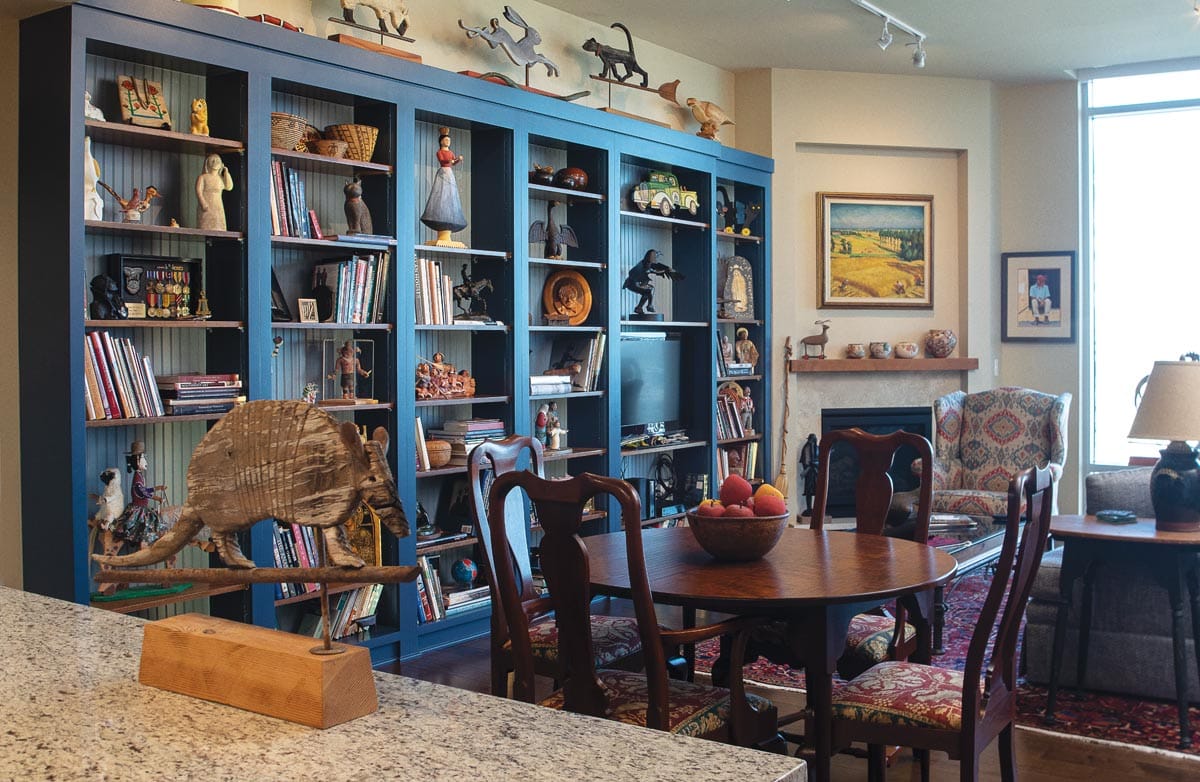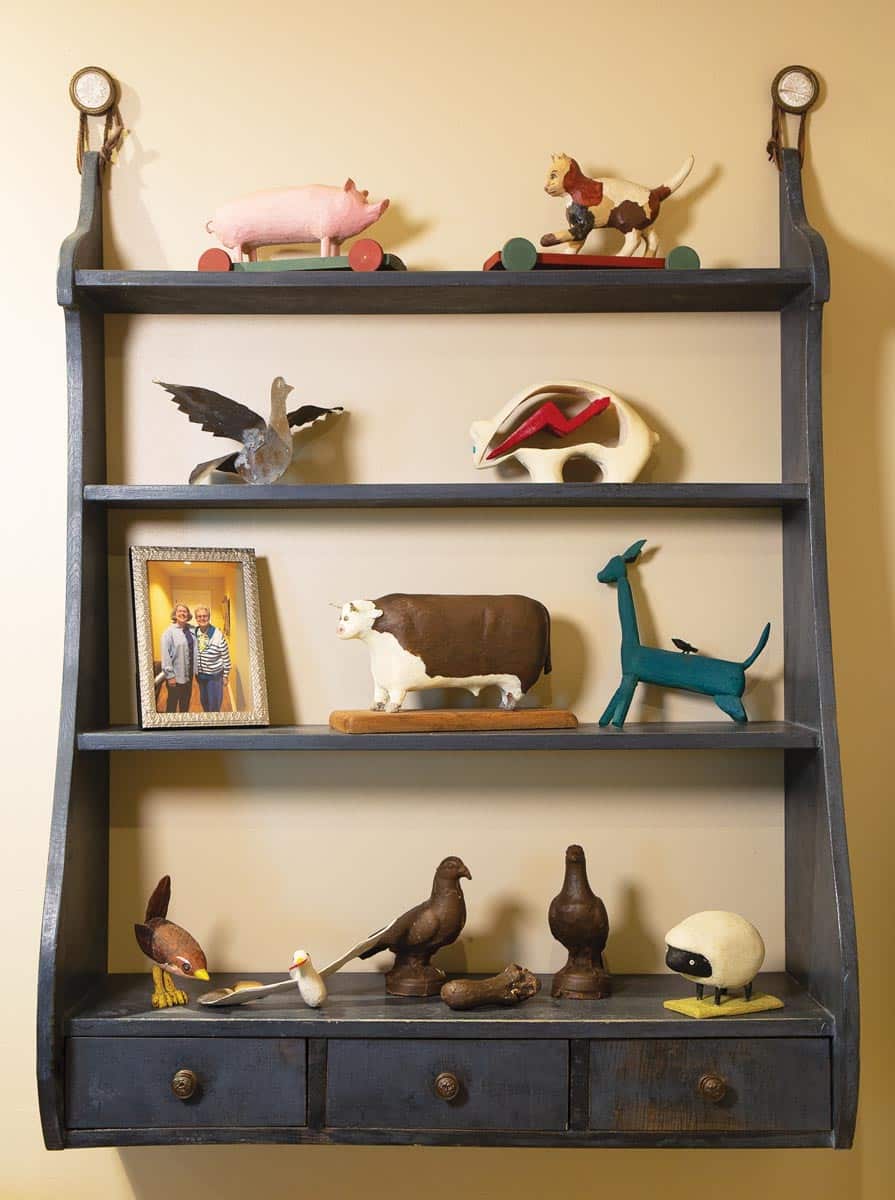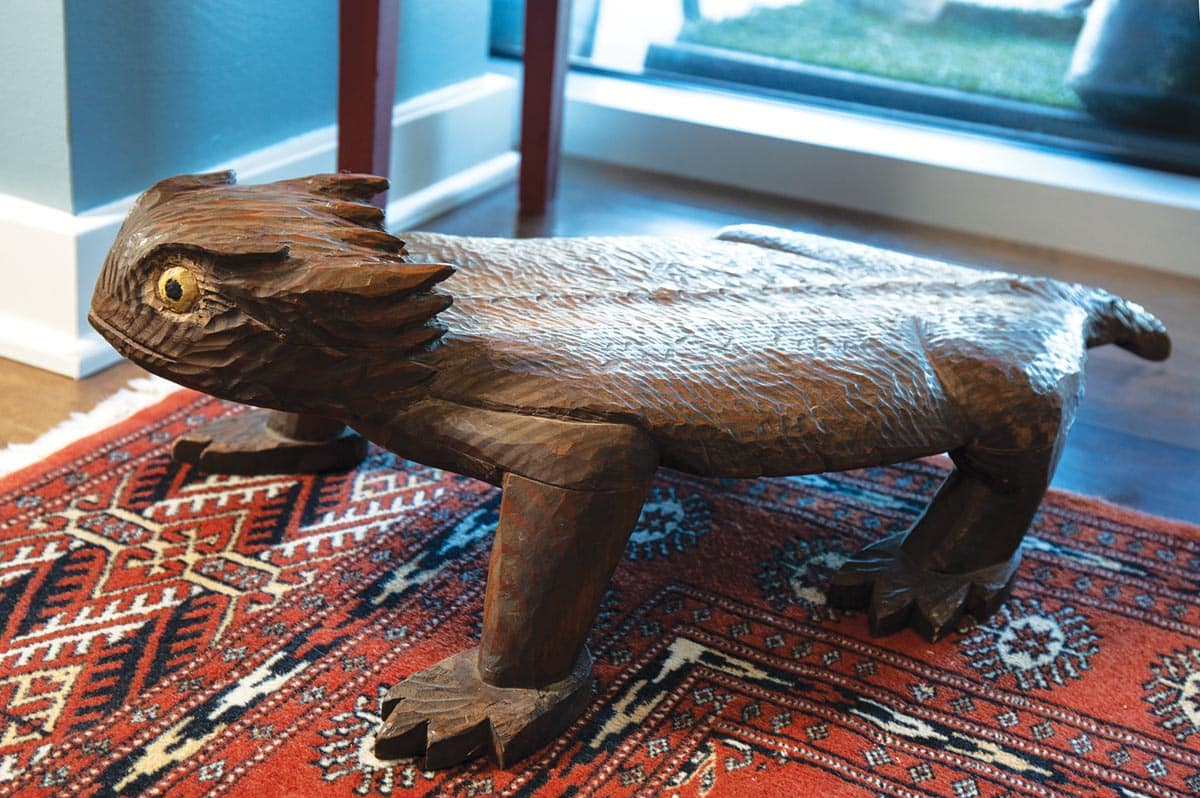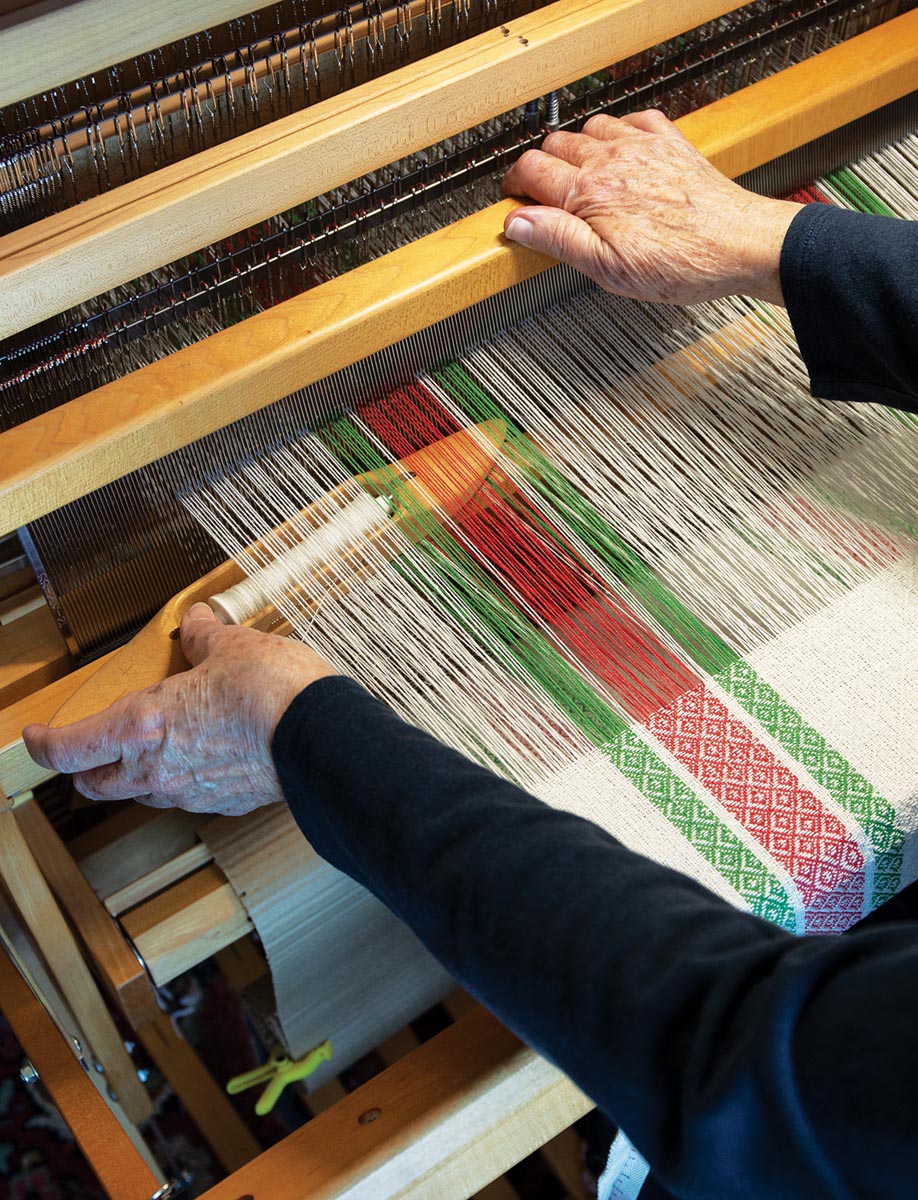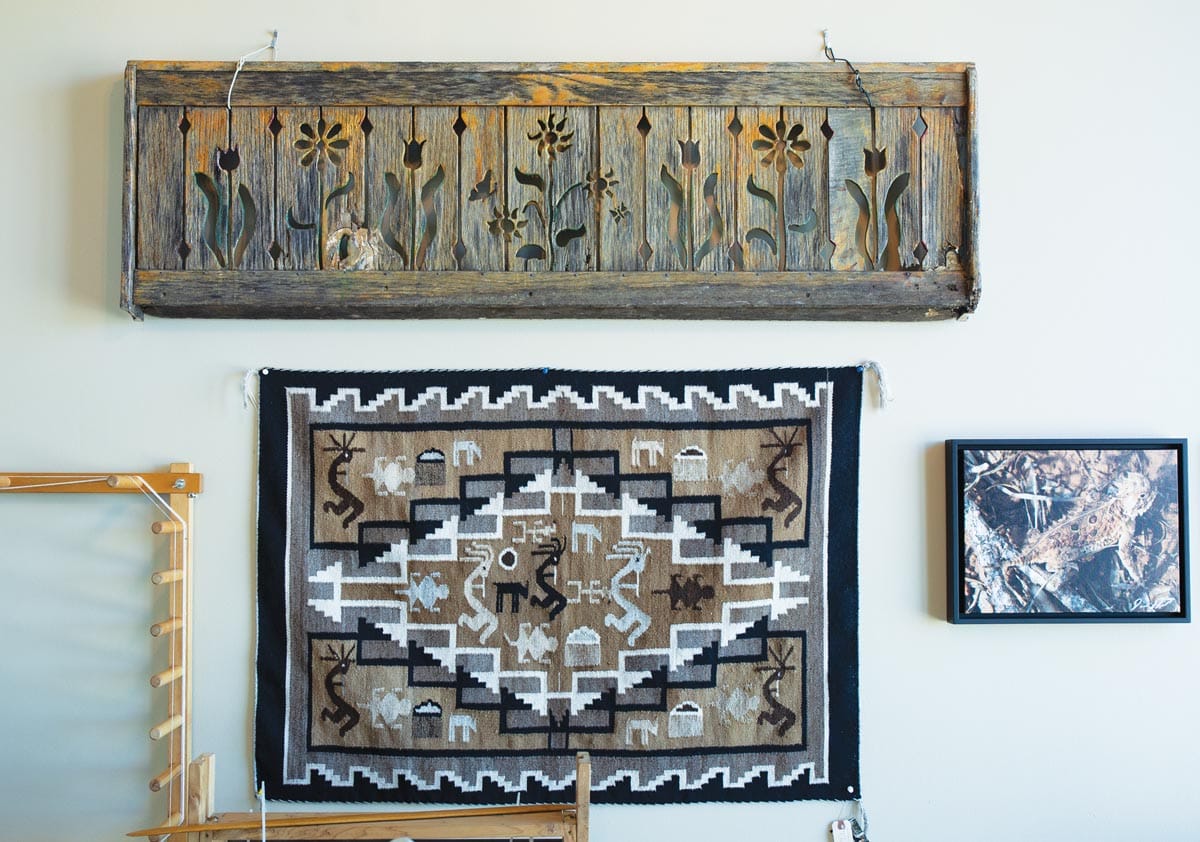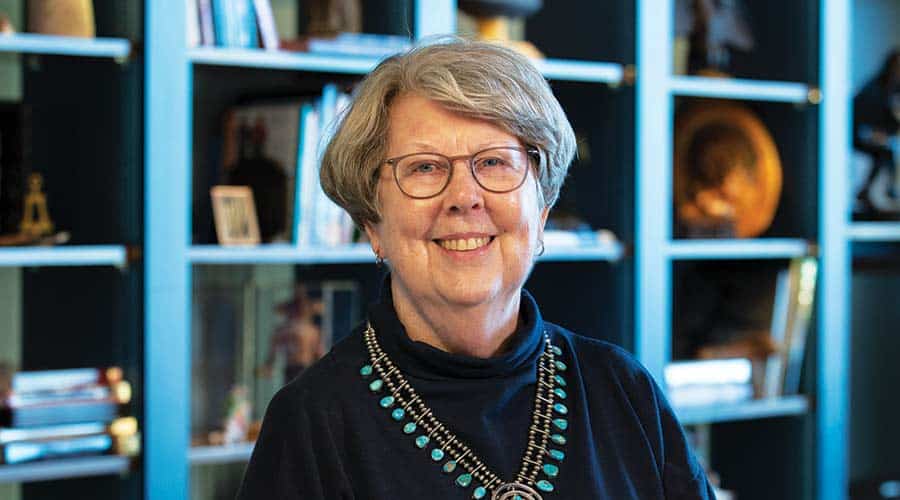
Home tour: Shared passion for collectibles, carved creatures and folk art keeps this woman’s memory of her husband alive
By Babs Rodriguez
Photos by Ralph Lauer
Jean Walbridge is surrounded by roosters, optimism and memories. Carved by her late husband, James “Jim” Clark, the fowl roost on shelves, hang on walls and strike poses on windowsills where they are silhouetted against a spectacular view across downtown Fort Worth.
We are seated on a deeply comfortable living room sofa that Jean chose with interior designer Deborah Reed for her high-rise apartment in Trinity Terrace, a luxe retirement community. A wall of glass makes the expansive vista very much a feature of the open kitchen/living space. The soft flow of light is further enhanced by track lighting that spotlights a wall of custom bookcases. The shelves are filled with dozens of Jim’s artworks — in wood, clay, metal and paint — along with folk art pieces that the couple collected separately and together during almost 25 years of marriage. Every piece holds a memory.
The couple married in 1996, about a year and a half after Jean ran into Jim at a grocery store. That’s where — over their shopping carts — the aerospace engineer, a former fighter pilot who’d moved to Fort Worth to work at what was then General Dynamics, shared that he was recently divorced. He then asked for advice on meeting nice women. Jean, who knew him casually through their church, suggested that some members of the congregation might be an option. Four months later, Jim asked her out to a ballet, promising to make dinner for them as part of the evening. Jean says, “I knew then that he was a good man.”
Jean Walbridge surrounds herself with art crafted by her late husband, Jim, along with pieces they bought together during their almost 25-year marriage. The collection includes weather vanes, critters of all varieties and even the bowl of wooden apples on the dining table. The shelves in her Trinity Terrace living room are custom.
After the couple married, they lived in a house near TCU, where Jim created his art in a garden studio. In addition to his signature roosters, the prolific woodcarver’s rustic pieces included a roster of farm animals, each displaying a whimsical charm. For a wedding present, Jim gifted Jean with a black cat resembling her kitty, Velvet, reimagined as an articulated and wheeled pull toy. The cat carving cozies up to a dachshund on a living room shelf. Other delightful pieces include weather vanes featuring carved cats, rabbits and sheep and a pair of realistic eagle sculptures, one a work in progress that Jean discovered when cleaning out for her move.
Jim’s death in 2020 was not sudden; Alzheimer’s slowly erased his phenomenal three-dimensional vision for projects of all sorts. It was left to Jean to winnow down the possessions that would fit in the 1,500-square-foot apartment she moved into a year ago. She shipped pieces of antique furniture and artwork to Jim’s son and daughter and gifted friends with a few things. But among the items she chose to keep, one of the most treasured pieces is also the most humble: Carved by Jim as the disease overtook him, the smoothly sanded form suggests a sculpted wood cow with leather ears dangling impossibly low, its eyes askew. It feels like a sacred object, emblematic of Jim’s tug of war as he struggled to keep his artistic skills from being wrested away.
As Jean made her hard choices, she asked Reed to consult. The designer had known Jim and Jean before they were a couple and understood their shared love of craftsmanship, folk and Native American art, and textiles. She worked with Jean to transport the spirit of the couple’s happy life together to the Trinity Terrace apartment while also honoring a fresh beginning.
The dining table and chairs were Jim and Jean’s, but the cushions have been reupholstered in fabric that had been their dining room curtains. “The fabric is beautiful,” Jean says, “and I knew it would just be thrown out.” The couple’s solid walnut pencil bed went to Jim’s son in New York, but Reed sourced a vintage-look iron bed frame for Jean’s apartment. A rustic footstool in the form of a horned frog hunkers beneath a table also crafted by Jim. Jean’s father’s favorite reading chair and its plush wicker-supported ottoman have been brightly reupholstered. The chair backs up to a span of glass which, as in the living room, includes a door to the unit’s well-furnished patio.
Although Jean prefers to talk about Jim’s creations, she has been a textiles fan since girlhood and is talented in the fiber arts. “Mother made all my clothes, of course, and I remember fingering the fabrics with delight.” In adulthood, Jean translated that joy into weaving lessons and membership in the Fort Worth Weavers Guild. It was while taking a class on the Navajo reservation in Window Rock, Arizona, that she realized “plain weave,” the over-and-under, under-and-over repeat of the Native American weaving, was in essence what she’d done to make potholders as a kid. The way the Navajo artisans used color in the threads to create images, motifs and dimension was eye-opening. A stellar example of such weaving hangs on a wall of Jean’s office/studio.
Central to the room is a floor loom on which she is weaving kitchen towels in an impossibly intricate pattern. Jean waves off praise. “When Jim was ill, I had little time to weave, and when I returned to it, I decided to start slow. Dish towels are usually simple to make, and really, no one notices if you’ve messed up.”
The backstories of Japanese paintings inherited from Jean’s mother, framed art photographs and other collected pieces in the room can’t compare to the love poem that is the back of a wood swing designed by Jim with a floral motif. Beautifully weathered from time in their garden, it now hangs as an artwork. Beneath it, a Navajo-style loom Jim made for Jean leans against a wall.
Jean laughs easily and often as we walk through the space in which every wall and surface (bathrooms included) feature paintings, sculpture and covetable textiles with his-mine-and-ours histories. But she shrugs off her own story, although she is proud of being one of the few women to receive a bachelor of business administration degree from TCU in the ’60s and of her stint as associate publisher of Cable Connection Magazine (a TV/cable guide produced years ago at the Fort Worth Star-Telegram). She later became an assistant to a chancellor at TCU as well as the first female secretary to the school’s board of trustees.
As we finish the tour of her sky island, she looks around and says, “I wondered if being 17 floors up would bother me, but I love it. I just think about living in New York City above Central Park.” We stop beside a bowl of wooden apples, and she picks one up. She recalls the morning that she’d drawn Jim’s attention to a couple of crudely carved fruits they had collected and asked him if he could make her some more. When she got home from work, she found a row of apples, each different. “He’d gone to the store and bought all these different apples and then replicated them perfectly,” she says.
“I had a wonderful life with Jim. He was the perfect man for me.”

